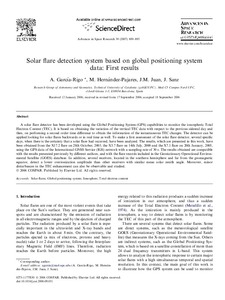Mostra el registre d'ítem simple
Solar flare detection system based on global positioning system data: first results
| dc.contributor.author | Hernández Pajares, Manuel |
| dc.contributor.author | Hernández Pajares, Manuel |
| dc.contributor.author | Juan Zornoza, José Miguel |
| dc.contributor.author | Sanz Subirana, Jaume |
| dc.contributor.other | Universitat Politècnica de Catalunya. Departament de Matemàtica Aplicada IV |
| dc.date.accessioned | 2007-11-22T14:43:27Z |
| dc.date.available | 2007-11-22T14:43:27Z |
| dc.date.created | 2006-01-12 |
| dc.date.issued | 2006-09-30 |
| dc.identifier.citation | García Rigo, Alberto; Hernández Pajares, Manuel; Juan Zornoza, José Miguel; Sanz Subirana, Jaume. “Solar flare detection system based on global positioning system data: first results”. Advances in space research, 2007, vol. 39, núm. 5, p. 889-895. ISSN 0273-1177. |
| dc.identifier.issn | 0273-1177 |
| dc.identifier.uri | http://hdl.handle.net/2117/1363 |
| dc.description.abstract | A solar flare detector has been developed using the Global Positioning System (GPS) capabilities to monitor the ionospheric Total Electron Content (TEC). It is based on obtaining the variation of the vertical TEC data with respect to the previous sidereal day and then, on performing a second order time difference to obtain the information of the instantaneous TEC changes. The detector can be applied looking for solar flares backwards or in real time as well. To make a first assessment of the solar flare detector, several specific days, when there is the certainty that a solar flare had occurred, have been analyzed. The results, which are presented in this work, have been obtained from the X17.2 flare on 28th October, 2003, the X5.7 flare on 14th July, 2000 and the X7.1 flare on 20th January, 2005, using the GPS data of the International GNSS Service (IGS) network with a sampling rate of 30 s. The results obtained are compatible with the results presented previously by different authors, and with the flare records included in the Geostationary Operational Environmental Satellite (GOES) database. In addition, several receivers, located in the southern hemisphere and far from the geomagnetic equator, detect a lower overionization amplitude than other receivers with similar mean solar zenith angle. Moreover, minor disturbances in the TEC enhancement can also be observable and studied. |
| dc.format.extent | 7 p. |
| dc.language.iso | eng |
| dc.publisher | Elsevier |
| dc.subject | Àrees temàtiques de la UPC::Matemàtiques i estadística::Matemàtica aplicada a les ciències |
| dc.subject.lcsh | Solar flares |
| dc.subject.lcsh | Global Positioning System |
| dc.subject.lcsh | Ionosphere |
| dc.subject.other | Solar flares |
| dc.subject.other | Global positioning system |
| dc.subject.other | Ionosphere |
| dc.subject.other | Total electron content |
| dc.title | Solar flare detection system based on global positioning system data: first results |
| dc.type | Article |
| dc.subject.lemac | Erupcions solars |
| dc.subject.lemac | Sistema de posicionament global |
| dc.subject.lemac | Ionosfera |
| dc.contributor.group | Universitat Politècnica de Catalunya. gAGE - Grup d'Astronomia i Geomàtica |
| dc.description.peerreviewed | Peer Reviewed |
| dc.subject.ams | Classificació AMS::85 Astronomy and astrophysics |
| dc.rights.access | Open Access |
| local.identifier.drac | 675937 |
| local.personalitzacitacio | true |
Fitxers d'aquest items
Aquest ítem apareix a les col·leccions següents
-
Articles de revista [85]
-
Articles de revista [3.267]


